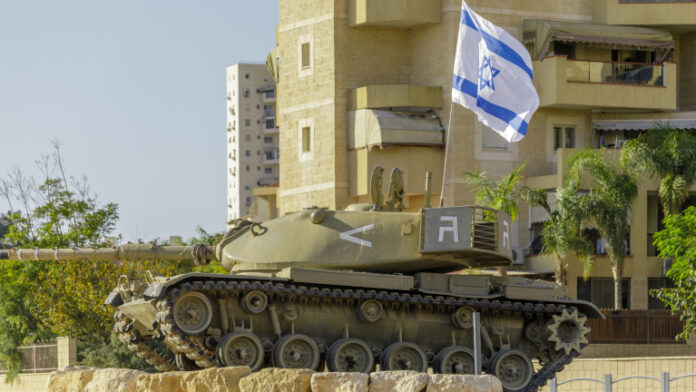Israeli Prime Minister Benjamin Netanyahu told the Israeli Nation that they are at war.
On October 7th, an unprecedented attack fell upon Israel. The Palestinian terrorist group Hamas which controls Gaza infiltrated Israeli borders and indiscriminately gunned down and killed hundreds of Israelis. According to Israeli officials, more than 1,400 people have been killed and over 3,400 injured. In addition, it is believed that Hamas has taken between 200 to 250 hostages.
According to reports and online video footage of the attack, Hamas terrorists created a multi-prong attack on small towns like Kibbutzim. Hamas terrorists paraglided down, stormed checkpoints on motorcycles, and entered by sea. According to officials, Hamas spent hours walking through towns killing anyone on site, and taking others as hostages.
On the Israeli side, in a televised address, Israeli Prime Minister Benjamin Netanyahu told the Israeli Nation that they are at war. Quickly implementing one of the largest mobilizations of the nation’s armies and executing a shock and awe style of bombing on Hamas and Palestinian landmarks in Gaza.
Preparations for a Ground Invasion
It was originally reported that an Israeli ground invasion may be imminent within the next 24 hours. However, that time has since passed, and Nations across the Middle East have a keen eye on this matter. The current situation in the Middle East is dire and creates a clear and present danger to non-militant civilians in Palestine.
Over the initial 48 hours, the Israeli military called up to 300,000 reservists to be quickly mobilized for war preparations, according to (IDF) Israeli Defense Force Spokesperson Daniel Hagari. This is said to have been one of the fastest mobilizations in history. Today, that number is well past 360,000 reservists.
There are concerns about the delay, some reports argue that moving that many civilians into southern Gaza isn’t a realistic expectation in such a small amount of time, before the ground invasion. Another reason could be threats imposed by Iran, stating that a ground invasion will not be tolerated and will cause Iran to Intervene. Thereby, expanding the scope of the war to other parts of the Middle East.
Other reports suggest that the recent visit of President Biden to Israel creates concerns of delays as Prime Minister Benjamin Netanyahu will not invade while President Biden is visiting for a show of support. However, is this show of support really an attempt to persuade Benjamin Netanyahu not to undertake a ground invasion at all?
The Iranian Variable
On the other side of the conflict, from Iran’s perspective, Hamas and Hezbollah are assets, as Iran is considerably vested in the survival of these organized terrorist groups and the survival of a Palestinian state. According to reports citing two diplomatic sources, Iran’s Foreign Minister Hossain Amirabdollahian warned that a ground invasion offensive in Gaza would likely force Iran to intervene.
Iran and Hamas have maintained a complex relationship over the years. Iran, a key regional player, has offered substantial financial and military support to Hamas. This support encompasses funding for Hamas’s social programs and military activities, including the provision of weaponry and training. These resources have empowered Hamas to maintain its control over the Gaza Strip and continue its resistance against Israel.
Both Iran and Hamas share common political objectives, notably their opposition to the existence of the state of Israel, leading to a lasting political alliance. This alliance has not only facilitated cooperation but also bolstered Hamas’s ability to challenge Israeli influence in the region.
However, the Iran-Hamas relationship is not without its intricacies. Over time, Hamas has been cautious in balancing its relations with various regional actors, including Iran. Iran’s support for Hamas serves its geopolitical interests, affording it influence in the Palestinian territories and providing a means to exert pressure on Israel. This has, at times, caused strains in Hamas’s relations with other Arab states, particularly those critical of Iran, such as Saudi Arabia and the Gulf states.
President Biden Send Warnings and Carriers to the Middle East
On October 8th, the United States announced that it was sending the USS Gerald R. Ford, considered one of the most advanced carriers, to the Eastern Mediterranean, which entered last week. In a statement from U.S. Central Command, which puts into perspective America’s intentions, highlighted that the entrance of the USS Gerald R. Ford into waters near Israel serves to, “deter any actors seeking to escalate the situation or widen this war”.
On October 10th President Biden condemned the terrorist organization Hamas and called the attacks, “Sheer Evil and Sickening”. In addition, President Biden committed to providing additional support in military aid such as ammunition, U.S. Navy ships, and planes.
In response to President Biden’s directives, the Dwight D. Eisenhower Carrier Strike Group embarked from its port in Norfolk, Virginia, on October 13, setting sail for the Mediterranean Sea. Concurrently, the Pentagon released an announcement on Thursday, confirming the relocation of additional American fighter aircraft to bases under U.S. jurisdiction within the region. This deployment reflects evolving U.S. military activities in a strategically significant area.
President Biden Gives the Order for Action
In a notable display of the United States’ commitment to Israel’s security, an American warship in the northern Red Sea successfully intercepted missiles and drones on Thursday. This operation underscores the extensive reach of the U.S. military’s protective capabilities over Israel, as directed by President Biden.
The USS Carney, an Arleigh Burke-class destroyer equipped with SM-2 sea-to-air missiles guided by radar systems, played a pivotal role in neutralizing the threat. These missiles and drones, potentially destined for targets in Israel, were effectively stopped in their tracks, as confirmed by Pentagon spokesman Ryder.
Ryder emphasized, “This action was a demonstration of the integrated air and defense architecture we have built in the Middle East, and we have prepared to utilize whatever necessary to protect our partners and our interests in the region,” This operation reflects the steadfast commitment of the United States to its allies in the region and its unwavering dedication to maintaining regional stability.
This is a developing story, come back to this report for updates.
Questions, comments, or if you want to advertise locally in the People’s Olive Branch, reach out to us at peoplesolivebranch@protonmail.com














